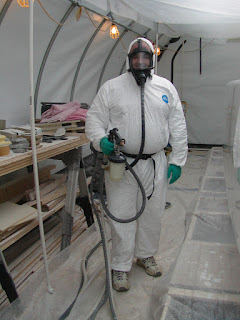The transom is one area where it's basically impossible to use machine screws, so I settled for sheet metal screws, attached through a core of high-density epoxy mix. Here's what the starboard looked like, before attaching the cover:
 The hole in the middle is obviously the air vent itself; Ian specifies a 2mm hole. I found the suggested SeaDog vent cover to be extremely flimsy and went instead with a Perko model, much more sturdier and nicer looking too IMO:
The hole in the middle is obviously the air vent itself; Ian specifies a 2mm hole. I found the suggested SeaDog vent cover to be extremely flimsy and went instead with a Perko model, much more sturdier and nicer looking too IMO:
Attaching the hatches was more tedious than I expected. Obviously you have to drill holes; I did this by first drilling small pilot holes with the hatch in place:
 Then drilling the final holes with the hatch removed:
Then drilling the final holes with the hatch removed: 
Silicon was the hatch-makers' recommended sealant, and although other alternatives exist (3m 4200\5200, LifeSeal, etc) I decided to stick with silicon to make it easy to remove the hatches in future. It was pointed out to me (thanks Henny) that silicon can make future paint jobs quite difficult - hopefully I don't come to regret this.
My procedure was to lay down the silicon bead around the underside of the hatch flange, then lay the hatch in its float hole, push the screws down through each hole, press the hatch down lightly to compress the silicon slightly, then leave it alone. I don't have any pictures of my silicon beads -- it was a warm day and I was trying hard to get each hatch in place immediately after applying silicon.
I don't think I was applying enough silicon on the first few hatches, based on the lack of squeeze-out; I'm not too worried since I know it's under there, but it'll be something to keep an eye on. An idea just occurred to me that I'll have to try: I can do leak-testing with the garden hose.
After leaving the hatches alone for 3-4 hours to cure (probably not a full cure, but that's as long as I was willing to wait), I got started attaching the nuts and washers. I used stainless steel machine screws and nuts purchased at Fisheries Supply in Seattle; it would have been more cost-effective to order in bulk, but I was in a hurry. Unfortunately F.S. was out-of-stock on S.S. lock washers, so I resorted to using flat washers plus some Loctite on each screw.
The large access hatches are pretty easy to do, but the 6" hatches can be tough to maneuver in. I was using nut-drivers which helped a lot but still had to wrap some masking tape around the nut-driver...

The final result:








































